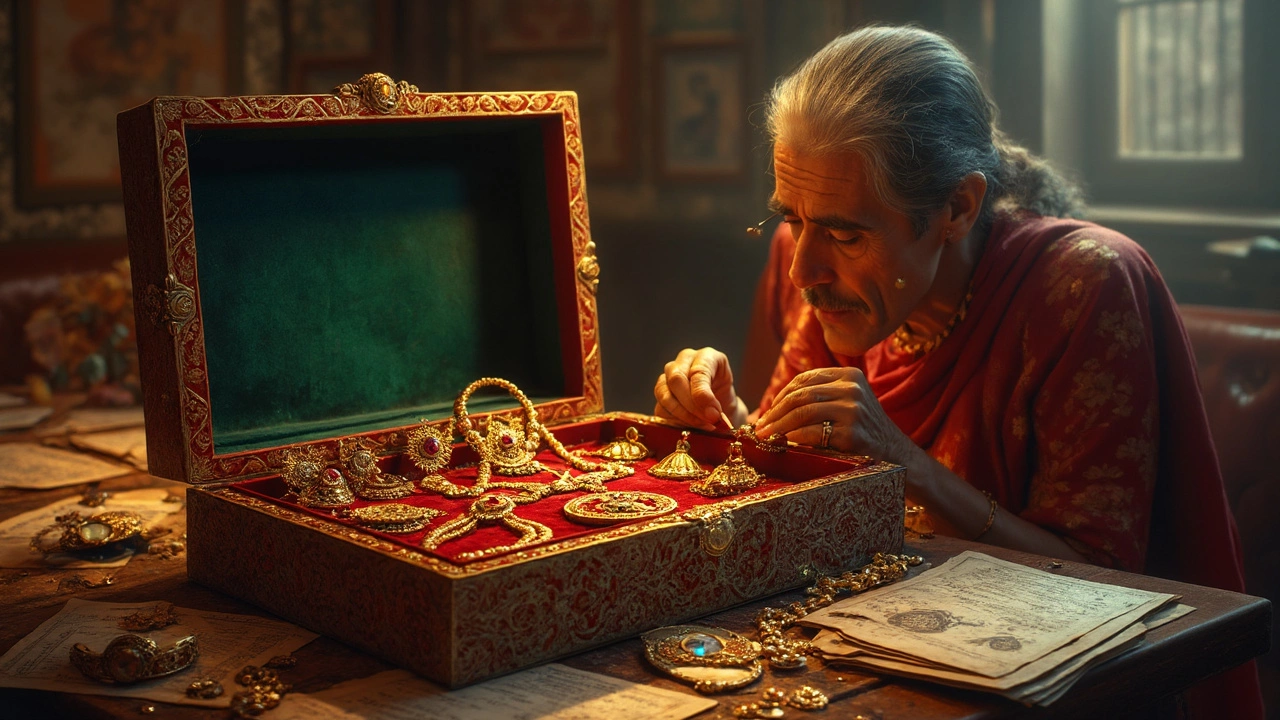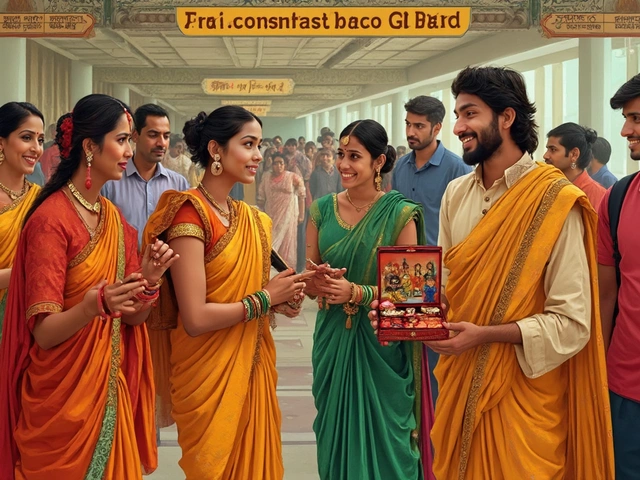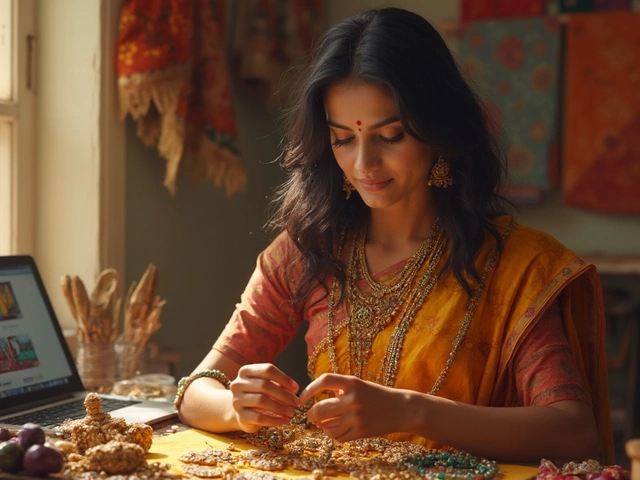
So you found a box of old rings and necklaces in your grandmother’s attic, and now you’re wondering if you’ve struck gold—literally and figuratively. Antique jewelry triggers all kinds of questions about value and future worth, and you’re not alone if you’re puzzled by how these old pieces hold up over time.
Here’s the deal: not every sparkling old gem is going to pad your retirement account. Some antique jewelry does hold its value—or even grows in price—while plenty of other pieces simply look pretty without much brag-worthy resale value. The big secret? It comes down to who made it, what it’s made of, when it was made, and how it looks today.
If you want to get past the guesswork, you need to understand the basics: material, maker, age, condition, and trends all play a role. Gold and platinum tend to survive market ups and downs better than silver, and pieces from well-known makers like Cartier or Tiffany & Co. are almost always a safer bet than no-name items. But even then, damage or poor repairs can turn a treasure into an ordinary trinket.
- Why Antique Jewelry Still Matters
- What Impacts Value Over Time?
- Condition Is Everything
- Rarity and Demand: The Game Changers
- How to Tell the Real Deal
- Tips for Buying and Keeping Value
Why Antique Jewelry Still Matters
People might think of grandma’s old brooches or Uncle Tony’s odd cufflinks and just see outdated stuff, but antique jewelry packs a punch nobody expects. For starters, it’s not just about how it looks—it’s about history. Every piece tells a story, sometimes stretching back a hundred years or more. If you dig into the details, you might spot the handiwork from craftsmen who learned their trade before smartphones and mass production were even a thing.
What really keeps antique jewelry in the spotlight is its one-of-a-kind nature. Modern retailers just can’t match the craftsmanship of the past. For example, jewelers from the Art Deco period (think 1920s and 1930s) created bold patterns with real gemstones and platinum, setting styles that still inspire top designers today. Even Queen Elizabeth II often wore antique brooches with deep meanings, linking jewelry to big moments in history.
And here’s something you might not realize: the environmental impact is far lower when you buy a vintage ring, instead of something brand new. The mining and refining for new gold or diamonds has a steep footprint. When you choose something old, you’re recycling luxe style and shrinking your environmental impact by a mile.
"The enduring appeal of antique jewelry lies in its unmatched artistry and the fact that each piece carries a unique story," says Clare Phillips, curator at the Victoria & Albert Museum Jewelry Gallery.
Collectors, too, understand why old pieces matter. Some jewelry collectors compare hunting for antique finds to collecting rare sneakers or baseball cards—it’s about rarity, history, and the thrill of the chase. And in recent years, high-profile auctions have set record prices for vintage Cartier, Georgian rings, and Edwardian tiaras. These aren’t just accessories—they’re legit investments and family heirlooms rolled into one.
If you ever get your hands on a real antique, you’re holding a slice of style, sustainability, and history—plus the potential for lasting value. That’s something fast fashion just can’t offer.
What Impacts Value Over Time?
When you’re figuring out if your antique jewelry will keep its value, you need to know what factors make the biggest difference. Value isn’t all about age—the market looks at a bunch of angles when putting a price on that old brooch.
The main things that sway value are:
- Material: Gold, platinum, and gem quality matter way more than you’d think. Jewelry made with high-karat gold or platinum usually survives price drops and trends. Lower-quality metals like silver are less stable, since their price can jump up and down.
- Makers and Brands: Names like Cartier, Tiffany & Co., or Van Cleef & Arpels crank up value. A ring with a famous stamp inside is way more likely to hold or grow in value than one with no mark at all.
- Era and Design: Art Deco (1920s–1930s), Victorian (1837–1901), and Edwardian (1901–1910) styles are almost always more valuable, simply because collectors chase them like crazy. Bold designs and rare stylistic features push the price up.
- Condition: Chips, missing stones, or past repairs slash value fast. Jewelry in original, untouched condition beats anything that’s been messed with.
- Market Trends: Some years, vintage engagement rings explode in popularity. Other years, colored gemstones like sapphires or emeralds are in. The market’s tastes move quick, so timing your sale can really matter.
Here’s a quick look at how a few key factors play out for antique jewelry value over time:
| Factor | Effect on Value |
|---|---|
| Gold Content | High gold content (18k/22k) = more stable value |
| Famous Maker | Brand name boosts resale by 30–80% |
| Original Condition | Can double or triple the price vs restored |
| Desirable Era | Art Deco items up to 50% more valuable |
| Market Demand | Trendy designs can see price jumps of 20%+ in a year |
So, what’s the takeaway? If you’ve got antique jewelry with strong material, a big brand, unique design, and it’s in great shape, odds are you’re holding something that’ll hold—or even increase—its value. Keep an eye on those market shifts, because what’s hot today might not be next year.
Condition Is Everything
Here’s the plain truth: the value of antique jewelry drops fast if it’s in rough shape. Collectors, dealers, and even casual buyers want pieces that look close to how they did when they left the maker’s workshop. Tiny chips, bent prongs, scratched stones, or missing bits can slash value in half—sometimes more.
If you’re looking at a piece from, say, the Victorian era, experts check for original settings, intact hallmarks, and unaltered stones. Clean, well-kept items bring the most money. Even tiny repairs, like a re-tipped prong or a newer clasp, should be done by professionals who know antique work. Amateur fixes stick out and usually tank resale price.
Take a look at some common condition factors that drive up or drag down what you can get for your jewelry:
- Antique jewelry with original enamel or intricate handwork will always be more valuable than items where details are missing or worn down.
- Water damage or corrosion on metal—big red flag, especially for silver pieces.
- Missing stones (even tiny ones) take away collector interest fast.
- Re-polished gems may look shinier but often lose value because original cuts matter for authenticity.
Here’s a quick look at how condition changes value in the real world:
| Status | Value Retention |
|---|---|
| Mint (no wear, all original parts) | 90-100% |
| Excellent (minor invisible repairs) | 70-90% |
| Good (some small wear or expert repairs) | 50-70% |
| Fair (noticeable flaws, amateur repairs) | 30-50% |
| Poor (broken, missing major parts) | 10-30% |
You can boost the value of what you have by making sure it’s clean and safely stored. For pricey pieces, a pro appraisal and careful, expert cleaning is worth it. My own kid, Eamon, once found an old brooch in a box of costume jewelry. After a basic wipe, it looked better—but a jeweler said a botched repair from years ago made it nearly worthless, even though it was over 100 years old. Ouch. Take care of your treasures, and they’ll take care of you.

Rarity and Demand: The Game Changers
When you talk antique jewelry value, two words come up over and over: rarity and demand. If something’s rare, that doesn’t always mean it’s wanted. But when a rare piece is also in high demand? Now you’re looking at a jackpot.
Let’s get real about rarity. Some styles, like Art Deco or Georgian pieces, weren’t cranked out in huge numbers. Plus, time takes its toll—things break, get lost, or melted down, making what’s left even more scarce. Add big names like Cartier into the mix, and you’ll see why certain necklaces or rings fetch way more than you’d expect. There are only so many original Cartier Panther bracelets left in the world. That’s why collectors go wild for them.
Demand works a bit differently. What’s trending today might not be hot next year. Right now, chunky gold signet rings, Victorian snake motifs, and colorful gemstone brooches are bringing in top bids at auction houses. If celebrities or influencers wear a particular antique style on the red carpet, prices often jump over 20% in a year according to recent Sotheby’s reports.
Here’s a quick look at how rarity and demand affect prices for antique jewelry:
| Style/Era | Supply | Current Demand | Value Trend (2020-2025) |
|---|---|---|---|
| Art Deco | Low | High | +30% |
| Victorian | Medium | Medium-High | +15% |
| Edwardian | Low | Low-Medium | +5% |
| Mid-Century Modern | High | Medium | +3% |
One thing to watch for: highly personalized items—like monogrammed lockets—usually don’t attract big crowds, even if they’re old. On the other hand, classic, recognizable designs that fit current tastes are a magnet for buyers.
- If you spot an antique jewel in an unusual material or a once-popular trend making a comeback, you might be looking at a future star.
- Always check if a designer piece is signed. Authentication is huge when supply is low and demand is climbing.
The bottom line? Even if something is super old, if nobody wants it, the value stays flat. The real wins happen when low supply meets a wave of buyers eager to get in on the action.
How to Tell the Real Deal
Trying to figure out if you’ve got a true piece of antique jewelry or just an old costume trinket isn’t always as simple as it looks on TV. There are real ways to tell if you’ve landed something of value, but you’ve got to pay attention to the details—not just how shiny or old it looks.
The first thing anybody should check is the hallmark. Real gold, platinum, and silver pieces usually have clear stamps inside the band or on the clasp. Look for numbers like “18K,” “750,” “925” for sterling silver, or even the maker’s name. If you spot brands like “Tiffany & Co.” or “Cartier,” that’s already a very strong sign it’s worth more.
- Hallmarks and Maker’s Marks: Missing marks can mean it’s not authentic, or just very old. Still, you want to see some type of mark as evidence.
- Craftsmanship: Flip the piece over and check the back. Antique rings and brooches were hand-made, so the finish underneath should look polished and neat, never rough or uneven.
- Gemstones: Antique jewelry usually has stones set by hand, not glued. You may spot small prongs, not big blobs of glue. Many old pieces used real gems, but sometimes glass or paste was used too—so having a jeweler test the stones can tell you fast.
- Patina: Real antique jewelry can show a soft, aged finish or light wear in places you always touch, like ring bands. It should not look brand new, unless it was kept in a safe all its life.
If you’re thinking, “How can I be sure?”—getting a professional appraisal is a smart move. A certified jewelry appraiser can check authenticity and give you an estimate of value. The cost is usually around $75 to $200 per item, depending on where you are and the complexity of the piece.
Check out this quick comparison table to spot big differences between real antique and fake jewelry:
| Feature | Antique Jewelry | Fake/Costume Jewelry |
|---|---|---|
| Materials | Gold, platinum, sterling silver, real gems | Base metals, gold plate, glass, plastic stones |
| Hallmarks | Inside, clear, recognized makers | Often missing or generic stamps |
| Craftsmanship | Handmade, detailed finish, solid prongs | Machine-made, rough backs, glued stones |
| Gemstone Setting | Prongs, carefully set, older cuts | Glue, loose, often modern styles |
| Value | Holds/increases in value if rare, branded | Loses value or holds little resale potential |
Here’s one last tip: always store documents, receipts, and old appraisals with the jewelry. Original paperwork can make a big difference if you ever want to sell. If you’re ever in doubt, don’t feel weird about asking for a second opinion.
Tips for Buying and Keeping Value
If you want your antique jewelry to actually hold its worth, you have to be strategic from the start. Rookie mistakes, like ignoring repairs or not checking authenticity, tank resale value more than most people realize.
Here’s what actually works if you care about investment value:
- Focus on genuine materials. Gold and platinum pieces generally hold value better than silver or plated items. Stones like natural diamonds, sapphires, and rubies usually perform better over time than glass or synthetic gems.
- Stick with named pieces when you can. A ring stamped “Cartier” or “Tiffany & Co.” will nearly always sell for more than a similar no-name design — even if both are antique and beautiful.
- Condition matters most. Avoid jewelry with cracks, chips, or obvious repairs. If possible, keep pieces in their original condition or get restoration done by a trusted professional — not some random goldsmith trying to make it look new again.
- Request paperwork and provenance. Any proof of origin or previous ownership can bump up value, especially if you have documentation from jewelry experts, auction houses, or historic events.
- Buy what’s actually rare or in demand. Art Deco pieces are especially hot, as are Victorian era cluster rings. Not every old piece is valuable, so check current demand before buying.
- Store and clean pieces gently. Harsh chemicals and regular jewelry cleaners can wreck antique settings. Get advice from a specialist if you aren’t sure how to clean something specific.
If numbers help, take a look at this quick breakdown. Here’s how certain types of antique jewelry have held up in resale markets according to tracked auction data over the last five years:
| Jewelry Type | Average Value Change (2019-2024) | Notes |
|---|---|---|
| High-end signed Art Deco Rings | +38% | Cartier and Van Cleef pieces drove market |
| Victorian Gold Lockets | +17% | Mainly for excellent condition, detailed designs |
| No-name Vintage Brooches | -10% | Most only kept scrap metal value |
| Platinum Diamond Bracelets | +22% | Major auction interest, especially for natural stones |
One last thing: If you ever plan to pass jewelry down (like I will with Eamon), keep records and store everything in a safe, dry spot. Future buyers and family members love a good backstory, and that paper trail can even tip the scale if they ever decide to sell. When in doubt, ask for advice — there’s no shame in double-checking before you drop serious cash on a so-called ‘investment’ piece.




Write a comment